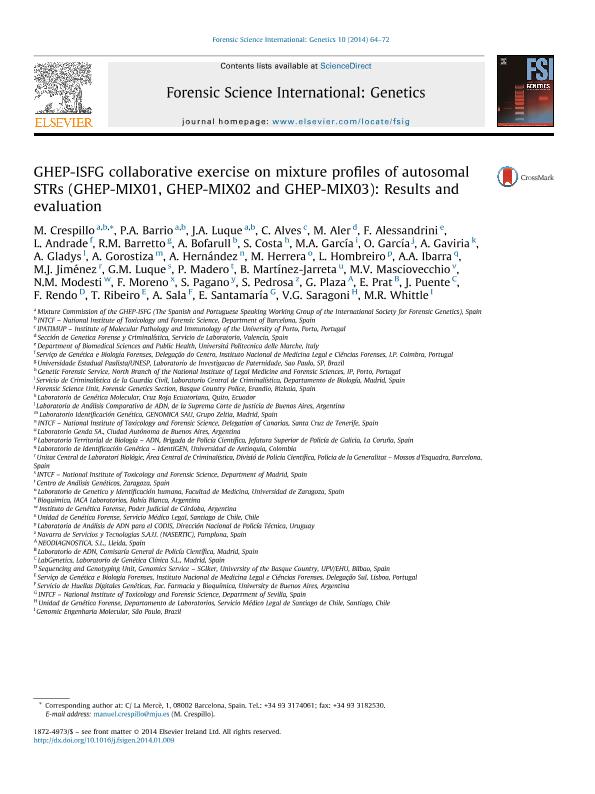Artículo
GHEP-ISFG collaborative exercise on mixture profiles of autosomal STRs (GHEP-MIX01, GHEP-MIX02 and GHEP-MIX03): results and evaluation
Sala, Adriana Andrea ; Crespillo, M.; Barrio, P. A.; Luque, J. A.; Alves, Cíntia; Aler, M.; Alessandrini, F.; Andrade, L.; Barretto, R. M.; Bofarull, A.; Costa, S.; García, M. A.; García, O.; Gaviria, A.; Gladys, A.; Gorostiza, A.; Hernández, A.; Herrera, M.; Hombreiro, L.; Ibarra, A. A.; Jiménez, M. J.; Luque, G. M.; Madero, P.; Martínez Jarreta, B.; Masciovecchio, M. Verónica; Modesti, Nidia Maria
; Crespillo, M.; Barrio, P. A.; Luque, J. A.; Alves, Cíntia; Aler, M.; Alessandrini, F.; Andrade, L.; Barretto, R. M.; Bofarull, A.; Costa, S.; García, M. A.; García, O.; Gaviria, A.; Gladys, A.; Gorostiza, A.; Hernández, A.; Herrera, M.; Hombreiro, L.; Ibarra, A. A.; Jiménez, M. J.; Luque, G. M.; Madero, P.; Martínez Jarreta, B.; Masciovecchio, M. Verónica; Modesti, Nidia Maria ; Moreno, F.; Pagano, S.; Pedrosa, S.; Plaza, G.; Prat, E.; Puente, J.; Rendo, F.; Ribeiro, T.; Santamaría, E.; Saragoni, V. G.; Whittle, M. R.
; Moreno, F.; Pagano, S.; Pedrosa, S.; Plaza, G.; Prat, E.; Puente, J.; Rendo, F.; Ribeiro, T.; Santamaría, E.; Saragoni, V. G.; Whittle, M. R.
 ; Crespillo, M.; Barrio, P. A.; Luque, J. A.; Alves, Cíntia; Aler, M.; Alessandrini, F.; Andrade, L.; Barretto, R. M.; Bofarull, A.; Costa, S.; García, M. A.; García, O.; Gaviria, A.; Gladys, A.; Gorostiza, A.; Hernández, A.; Herrera, M.; Hombreiro, L.; Ibarra, A. A.; Jiménez, M. J.; Luque, G. M.; Madero, P.; Martínez Jarreta, B.; Masciovecchio, M. Verónica; Modesti, Nidia Maria
; Crespillo, M.; Barrio, P. A.; Luque, J. A.; Alves, Cíntia; Aler, M.; Alessandrini, F.; Andrade, L.; Barretto, R. M.; Bofarull, A.; Costa, S.; García, M. A.; García, O.; Gaviria, A.; Gladys, A.; Gorostiza, A.; Hernández, A.; Herrera, M.; Hombreiro, L.; Ibarra, A. A.; Jiménez, M. J.; Luque, G. M.; Madero, P.; Martínez Jarreta, B.; Masciovecchio, M. Verónica; Modesti, Nidia Maria ; Moreno, F.; Pagano, S.; Pedrosa, S.; Plaza, G.; Prat, E.; Puente, J.; Rendo, F.; Ribeiro, T.; Santamaría, E.; Saragoni, V. G.; Whittle, M. R.
; Moreno, F.; Pagano, S.; Pedrosa, S.; Plaza, G.; Prat, E.; Puente, J.; Rendo, F.; Ribeiro, T.; Santamaría, E.; Saragoni, V. G.; Whittle, M. R.
Fecha de publicación:
02/2014
Editorial:
Elsevier Ireland
Revista:
Forensic Science International: Genetics
ISSN:
1872-4973
Idioma:
Inglés
Tipo de recurso:
Artículo publicado
Clasificación temática:
Resumen
One of the main objectives of the Spanish and Portuguese-Speaking Group of the International Society for Forensic Genetics (GHEP-ISFG) is to promote and contribute to the development and dissemination of scientific knowledge in the area of forensic genetics. Due to this fact, GHEP-ISFG holds different working commissions that are set up to develop activities in scientific aspects of general interest. One of them, the Mixture Commission of GHEP-ISFG, has organized annually, since 2009, a collaborative exercise on analysis and interpretation of autosomal short tandem repeat (STR) mixture profiles. Until now, three exercises have been organized (GHEP-MIX01, GHEP-MIX02 and GHEP-MIX03), with 32, 24 and 17 participant laboratories respectively. The exercise aims to give a general vision by addressing, through the proposal of mock cases, aspects related to the edition of mixture profiles and the statistical treatment. The main conclusions obtained from these exercises may be summarized as follows. Firstly, the data show an increased tendency of the laboratories toward validation of DNA mixture profiles analysis following international recommendations (ISO/IEC 17025:2005). Secondly, the majority of discrepancies are mainly encountered in stutters positions (53.4%, 96.0% and 74.9%, respectively for the three editions). On the other hand, the results submitted reveal the importance of performing duplicate analysis by using different kits in order to reduce errors as much as possible. Regarding the statistical aspect (GHEP-MIX02 and 03), all participants employed the likelihood ratio (LR) parameter to evaluate the statistical compatibility and the formulas employed were quite similar. When the hypotheses to evaluate the LR value were locked by the coordinators (GHEP-MIX02) the results revealed a minor number of discrepancies that were mainly due to clerical reasons. However, the GHEP-MIX03 exercise allowed the participants to freely come up with their own hypotheses to calculate the LR value. In this situation the laboratories reported several options to explain the mock cases proposed and therefore significant differences between the final LR values were obtained. Complete information concerning the background of the criminal case is a critical aspect in order to select the adequate hypotheses to calculate the LR value. Although this should be a task for the judicial court to decide, it is important for the expert to account for the different possibilities and scenarios, and also offer this expertise to the judge. In addition, continuing education in the analysis and interpretation of mixture DNA profiles may also be a priority for the vast majority of forensic laboratories.
Archivos asociados
Licencia
Identificadores
Colecciones
Articulos(OCA HOUSSAY)
Articulos de OFICINA DE COORDINACION ADMINISTRATIVA HOUSSAY
Articulos de OFICINA DE COORDINACION ADMINISTRATIVA HOUSSAY
Citación
Sala, Adriana Andrea; Crespillo, M.; Barrio, P. A.; Luque, J. A.; Alves, Cíntia; et al.; GHEP-ISFG collaborative exercise on mixture profiles of autosomal STRs (GHEP-MIX01, GHEP-MIX02 and GHEP-MIX03): results and evaluation; Elsevier Ireland; Forensic Science International: Genetics; 10; 2-2014; 64-72
Compartir
Altmétricas



